2023 FORD F150 wheel
[x] Cancel search: wheelPage 288 of 786

WHAT IS THE ELECTRONIC
LOCKING DIFFERENTIAL
The electronic locking differential is adevice housed in the rear axle, and canprovide additional traction when needed.
HOW DOES THE ELECTRONIC
LOCKING DIFFERENTIAL
WORK - EXCLUDING: RAPTOR
You can activate the differentialelectronically and shift it on the fly withinthe operating speed range. The electronicdifferential disengages when the vehiclespeed exceeds a set value, and reengageswhen the vehicle speed goes below a setvalue. See Switching the ElectronicLocking Differential On and Off (page285). It also engages based on certainselected drive modes. See Selecting aDrive Mode (page 363). The electroniclocking differential is for use in mud, rocks,sand, or any off-road condition where youneed maximum traction.
Note:The electronic locking differential canactivate or deactivate automatically basedon speed, four-wheel drive mode, and drivemode selection. See Switching theElectronic Locking Differential On andOff (page 285).
Note:The electronic locking differential isfor off-road use only and is not for use ondry pavement. Using the electronic lockingdifferential on dry pavement results inincreased tire wear, noise and vibration.
Note:Do not perform this operation whencruise control or trail control are selectedand active. The system may not engage asexpected.
HOW DOES THE ELECTRONIC
LOCKING DIFFERENTIAL
WORK - RAPTOR
You can activate the differentialelectronically and shift it on the fly withinthe operating speed range. The electronicdifferential disengages when the vehiclespeed exceeds a set value and it reengageswhen the vehicle speed goes below a setvalue depending on drive mode. SeeSwitching the Electronic LockingDifferential On and Off (page 285). Theelectronic locking differential is for use inmud, rocks, sand, or any off-road conditionwhere you need maximum traction.
Note:The electronic locking differential canactivate or deactivate automatically basedon speed, four-wheel drive mode, and drivemode selection. See Switching theElectronic Locking Differential On andOff (page 285).
Note:The electronic locking differential isfor off-road use only and is not for use ondry pavement. Using the electronic lockingdifferential on dry pavement results inincreased tire wear, noise and vibration.
Note:The electronic locking differential isnot available in 2H.
Note:Do not perform this operation whencruise control or trail control are selectedand active. The system may not engage asexpected.
284
2023 F-150 (TFD) Canada/United States of America, enUSA, Edition date: 202206, DOMElectronic Locking Differential (If Equipped)
Page 289 of 786

ELECTRONIC LOCKING
DIFFERENTIAL PRECAUTIONS
Operating the Electronic LockingDifferential with a Spare orMismatched Tires
On vehicles with an electronic lockingdifferential, the size of the spare tire canaffect performance of the system. If thereis a significant difference between the tworear tires, you may have limited electroniclocking differential functionality. If thesystem has difficulty disengaging, releasethe accelerator pedal and turn the steeringwheel in the opposite direction whenrolling. We recommend engaging anddisengaging the electronic lockingdifferential at a stop when you mount aspare on the rear axle.
SWITCHING THE ELECTRONIC
LOCKING DIFFERENTIAL ON
AND OFF - 4X4, EXCLUDING:
RAPTOR
The button to activate and deactivate theelectronic locking differential is in thecenter of the drive mode rotary switch.
To manually activate or deactivate theelectronic locking differential, press theelectronic locking differential button.
285
2023 F-150 (TFD) Canada/United States of America, enUSA, Edition date: 202206, DOMElectronic Locking Differential (If Equipped)E323655 E308146
Page 290 of 786
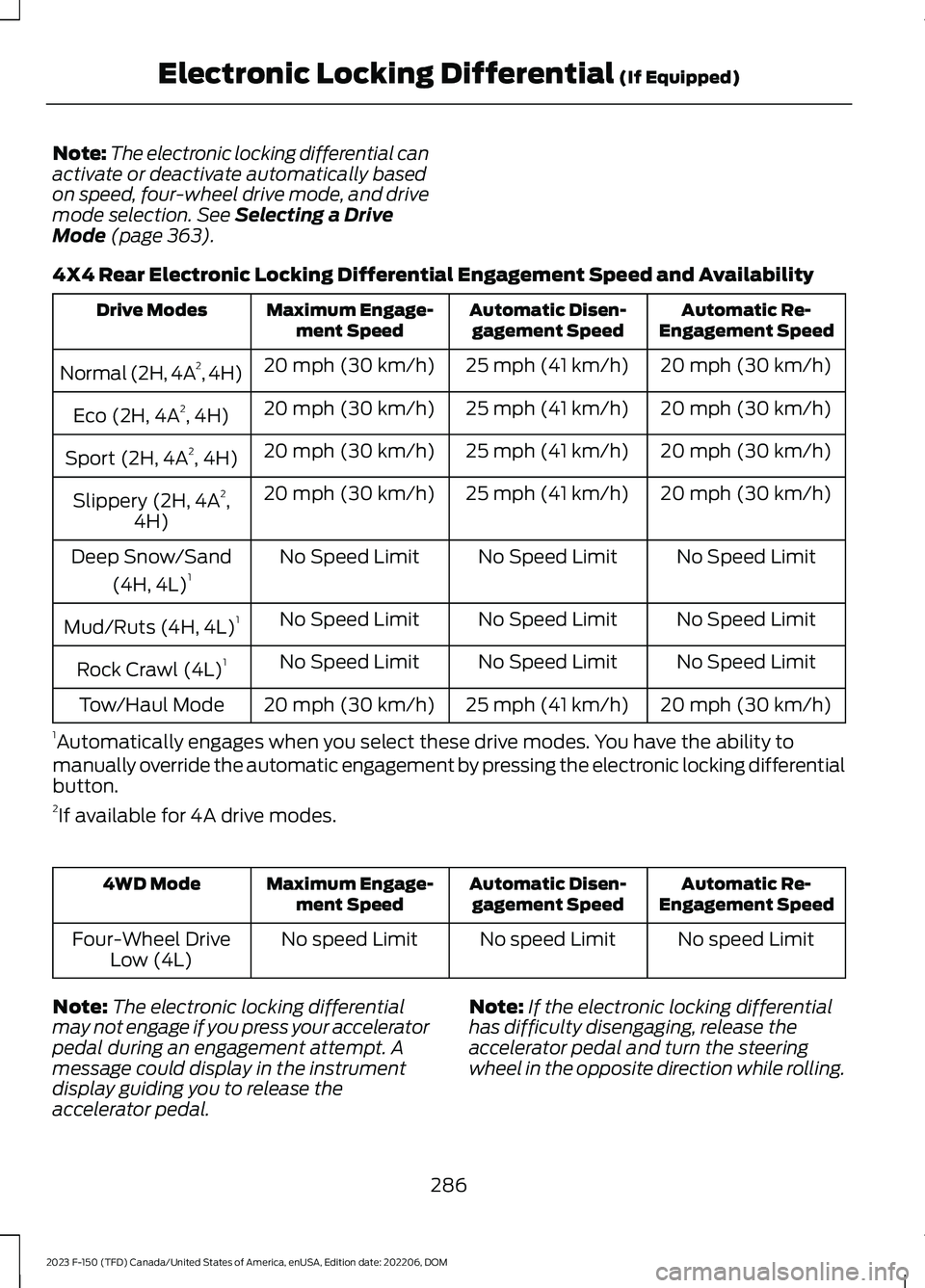
Note:The electronic locking differential canactivate or deactivate automatically basedon speed, four-wheel drive mode, and drivemode selection. See Selecting a DriveMode (page 363).
4X4 Rear Electronic Locking Differential Engagement Speed and Availability
Automatic Re-Engagement SpeedAutomatic Disen-gagement SpeedMaximum Engage-ment SpeedDrive Modes
20 mph (30 km/h)25 mph (41 km/h)20 mph (30 km/h)Normal (2H, 4A2, 4H)
20 mph (30 km/h)25 mph (41 km/h)20 mph (30 km/h)Eco (2H, 4A2, 4H)
20 mph (30 km/h)25 mph (41 km/h)20 mph (30 km/h)Sport (2H, 4A2, 4H)
20 mph (30 km/h)25 mph (41 km/h)20 mph (30 km/h)Slippery (2H, 4A2,4H)
No Speed LimitNo Speed LimitNo Speed LimitDeep Snow/Sand
(4H, 4L)1
No Speed LimitNo Speed LimitNo Speed LimitMud/Ruts (4H, 4L)1
No Speed LimitNo Speed LimitNo Speed LimitRock Crawl (4L)1
20 mph (30 km/h)25 mph (41 km/h)20 mph (30 km/h)Tow/Haul Mode
1Automatically engages when you select these drive modes. You have the ability tomanually override the automatic engagement by pressing the electronic locking differentialbutton.2If available for 4A drive modes.
Automatic Re-Engagement SpeedAutomatic Disen-gagement SpeedMaximum Engage-ment Speed4WD Mode
No speed LimitNo speed LimitNo speed LimitFour-Wheel DriveLow (4L)
Note:The electronic locking differentialmay not engage if you press your acceleratorpedal during an engagement attempt. Amessage could display in the instrumentdisplay guiding you to release theaccelerator pedal.
Note:If the electronic locking differentialhas difficulty disengaging, release theaccelerator pedal and turn the steeringwheel in the opposite direction while rolling.
286
2023 F-150 (TFD) Canada/United States of America, enUSA, Edition date: 202206, DOMElectronic Locking Differential (If Equipped)
Page 291 of 786
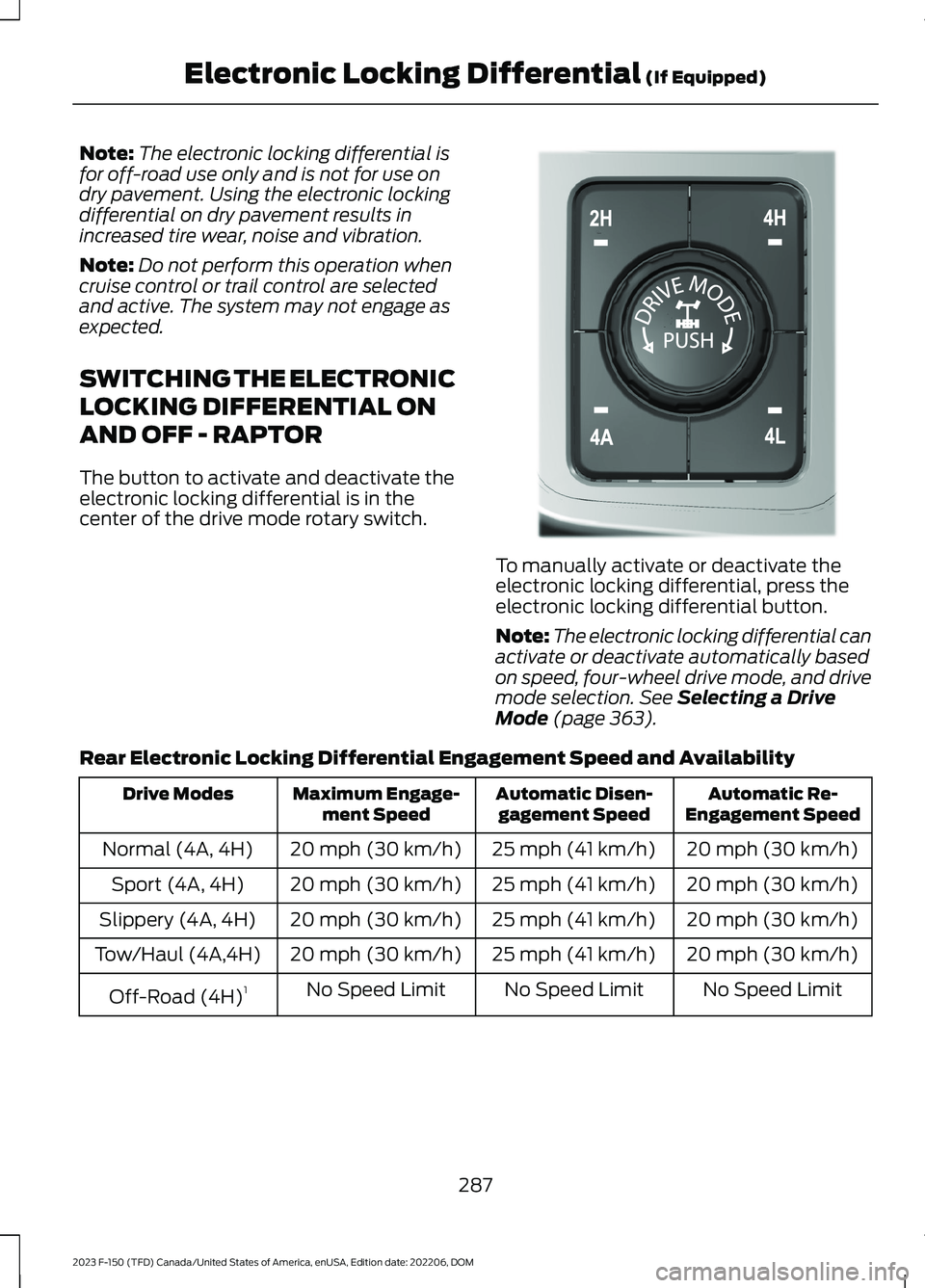
Note:The electronic locking differential isfor off-road use only and is not for use ondry pavement. Using the electronic lockingdifferential on dry pavement results inincreased tire wear, noise and vibration.
Note:Do not perform this operation whencruise control or trail control are selectedand active. The system may not engage asexpected.
SWITCHING THE ELECTRONIC
LOCKING DIFFERENTIAL ON
AND OFF - RAPTOR
The button to activate and deactivate theelectronic locking differential is in thecenter of the drive mode rotary switch.
To manually activate or deactivate theelectronic locking differential, press theelectronic locking differential button.
Note:The electronic locking differential canactivate or deactivate automatically basedon speed, four-wheel drive mode, and drivemode selection. See Selecting a DriveMode (page 363).
Rear Electronic Locking Differential Engagement Speed and Availability
Automatic Re-Engagement SpeedAutomatic Disen-gagement SpeedMaximum Engage-ment SpeedDrive Modes
20 mph (30 km/h)25 mph (41 km/h)20 mph (30 km/h)Normal (4A, 4H)
20 mph (30 km/h)25 mph (41 km/h)20 mph (30 km/h)Sport (4A, 4H)
20 mph (30 km/h)25 mph (41 km/h)20 mph (30 km/h)Slippery (4A, 4H)
20 mph (30 km/h)25 mph (41 km/h)20 mph (30 km/h)Tow/Haul (4A,4H)
No Speed LimitNo Speed LimitNo Speed LimitOff-Road (4H)1
287
2023 F-150 (TFD) Canada/United States of America, enUSA, Edition date: 202206, DOMElectronic Locking Differential (If Equipped)E308146
Page 292 of 786
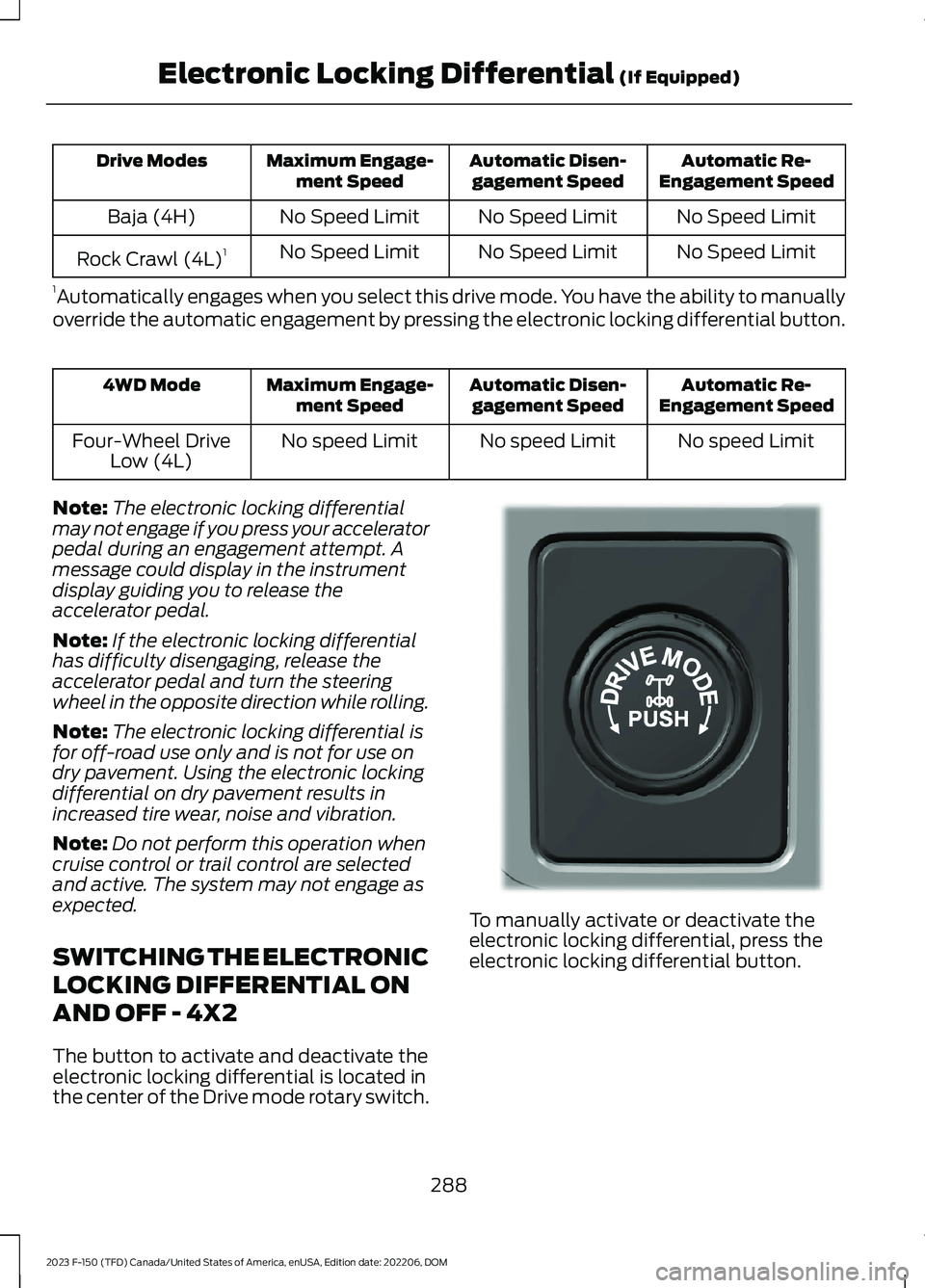
Automatic Re-Engagement SpeedAutomatic Disen-gagement SpeedMaximum Engage-ment SpeedDrive Modes
No Speed LimitNo Speed LimitNo Speed LimitBaja (4H)
No Speed LimitNo Speed LimitNo Speed LimitRock Crawl (4L)1
1Automatically engages when you select this drive mode. You have the ability to manuallyoverride the automatic engagement by pressing the electronic locking differential button.
Automatic Re-Engagement SpeedAutomatic Disen-gagement SpeedMaximum Engage-ment Speed4WD Mode
No speed LimitNo speed LimitNo speed LimitFour-Wheel DriveLow (4L)
Note:The electronic locking differentialmay not engage if you press your acceleratorpedal during an engagement attempt. Amessage could display in the instrumentdisplay guiding you to release theaccelerator pedal.
Note:If the electronic locking differentialhas difficulty disengaging, release theaccelerator pedal and turn the steeringwheel in the opposite direction while rolling.
Note:The electronic locking differential isfor off-road use only and is not for use ondry pavement. Using the electronic lockingdifferential on dry pavement results inincreased tire wear, noise and vibration.
Note:Do not perform this operation whencruise control or trail control are selectedand active. The system may not engage asexpected.
SWITCHING THE ELECTRONIC
LOCKING DIFFERENTIAL ON
AND OFF - 4X2
The button to activate and deactivate theelectronic locking differential is located inthe center of the Drive mode rotary switch.
To manually activate or deactivate theelectronic locking differential, press theelectronic locking differential button.
288
2023 F-150 (TFD) Canada/United States of America, enUSA, Edition date: 202206, DOMElectronic Locking Differential (If Equipped)E333748
Page 293 of 786
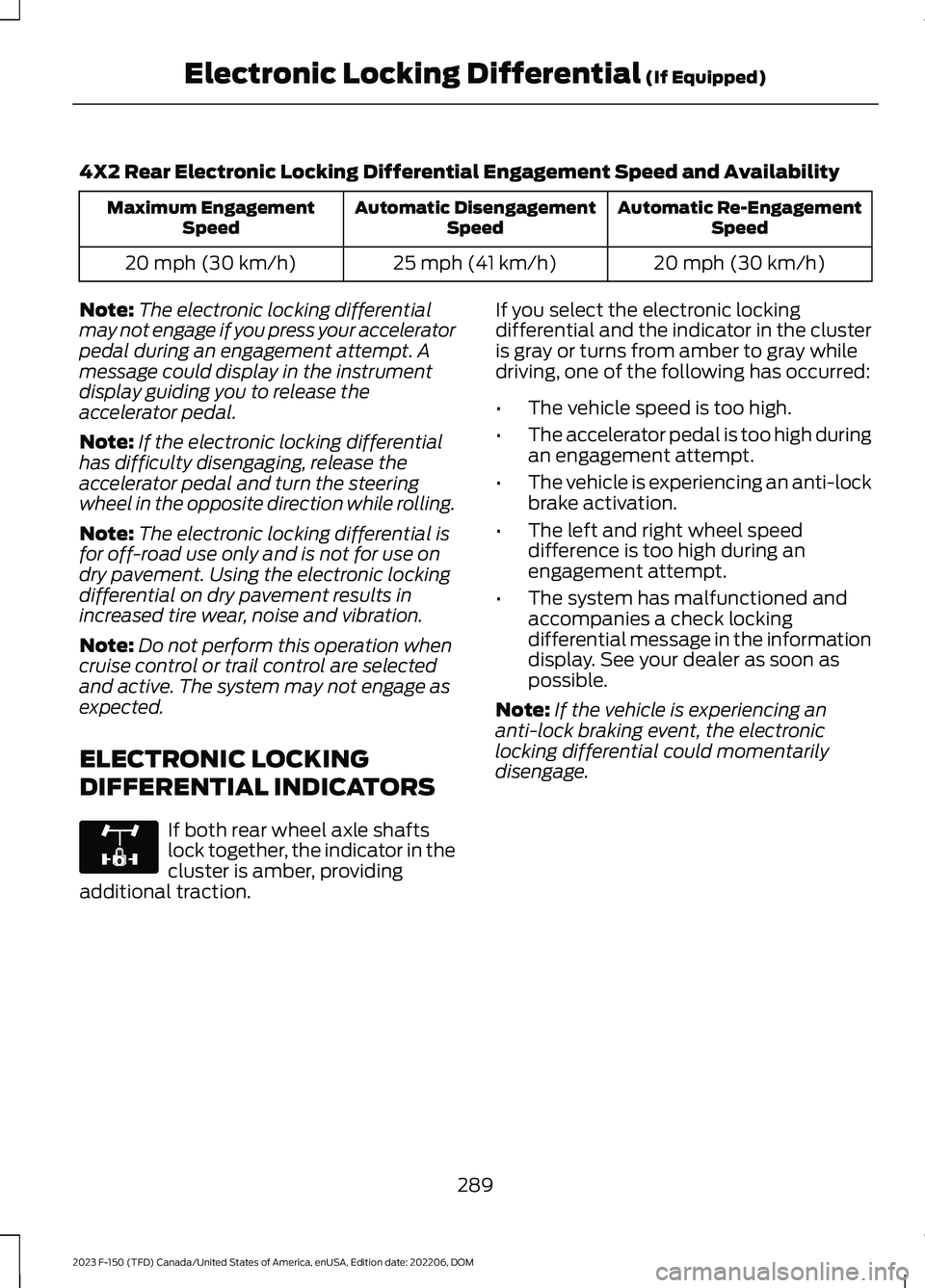
4X2 Rear Electronic Locking Differential Engagement Speed and Availability
Automatic Re-EngagementSpeedAutomatic DisengagementSpeedMaximum EngagementSpeed
20 mph (30 km/h)25 mph (41 km/h)20 mph (30 km/h)
Note:The electronic locking differentialmay not engage if you press your acceleratorpedal during an engagement attempt. Amessage could display in the instrumentdisplay guiding you to release theaccelerator pedal.
Note:If the electronic locking differentialhas difficulty disengaging, release theaccelerator pedal and turn the steeringwheel in the opposite direction while rolling.
Note:The electronic locking differential isfor off-road use only and is not for use ondry pavement. Using the electronic lockingdifferential on dry pavement results inincreased tire wear, noise and vibration.
Note:Do not perform this operation whencruise control or trail control are selectedand active. The system may not engage asexpected.
ELECTRONIC LOCKING
DIFFERENTIAL INDICATORS
If both rear wheel axle shaftslock together, the indicator in thecluster is amber, providingadditional traction.
If you select the electronic lockingdifferential and the indicator in the clusteris gray or turns from amber to gray whiledriving, one of the following has occurred:
•The vehicle speed is too high.
•The accelerator pedal is too high duringan engagement attempt.
•The vehicle is experiencing an anti-lockbrake activation.
•The left and right wheel speeddifference is too high during anengagement attempt.
•The system has malfunctioned andaccompanies a check lockingdifferential message in the informationdisplay. See your dealer as soon aspossible.
Note:If the vehicle is experiencing ananti-lock braking event, the electroniclocking differential could momentarilydisengage.
289
2023 F-150 (TFD) Canada/United States of America, enUSA, Edition date: 202206, DOMElectronic Locking Differential (If Equipped)E325779
Page 297 of 786
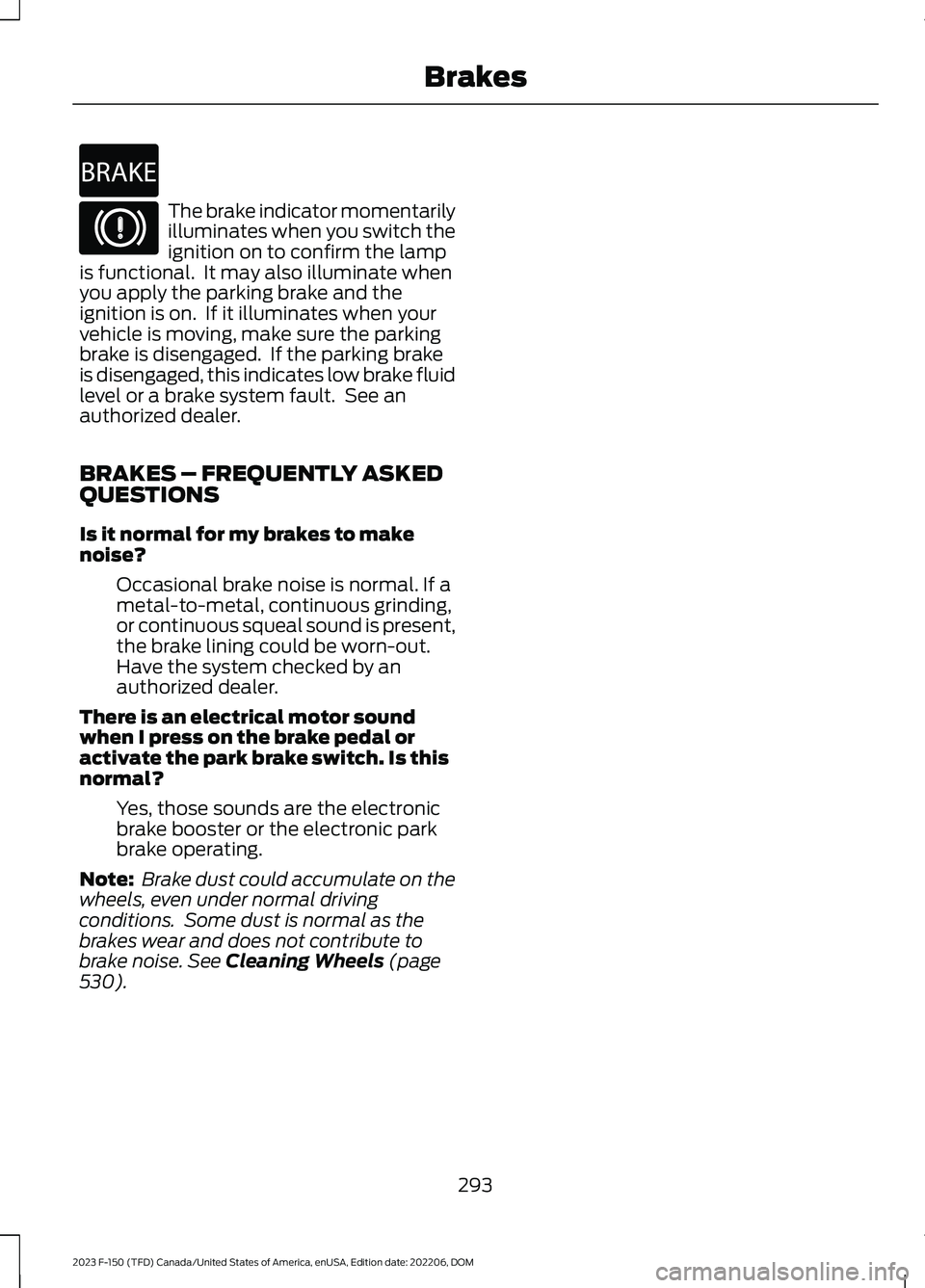
The brake indicator momentarilyilluminates when you switch theignition on to confirm the lampis functional. It may also illuminate whenyou apply the parking brake and theignition is on. If it illuminates when yourvehicle is moving, make sure the parkingbrake is disengaged. If the parking brakeis disengaged, this indicates low brake fluidlevel or a brake system fault. See anauthorized dealer.
BRAKES – FREQUENTLY ASKEDQUESTIONS
Is it normal for my brakes to makenoise?
Occasional brake noise is normal. If ametal-to-metal, continuous grinding,or continuous squeal sound is present,the brake lining could be worn-out.Have the system checked by anauthorized dealer.
There is an electrical motor soundwhen I press on the brake pedal oractivate the park brake switch. Is thisnormal?
Yes, those sounds are the electronicbrake booster or the electronic parkbrake operating.
Note: Brake dust could accumulate on thewheels, even under normal drivingconditions. Some dust is normal as thebrakes wear and does not contribute tobrake noise. See Cleaning Wheels (page530).
293
2023 F-150 (TFD) Canada/United States of America, enUSA, Edition date: 202206, DOMBrakesE270480 E67024
Page 304 of 786

REVERSE BRAKING ASSIST –FREQUENTLY ASKED QUESTIONS
Why is reverse braking assist unavailable?
•Make sure the reverse braking assist ison. See Switching Reverse BrakingAssist On and Off (page 298).
•Make sure that all doors, liftgate ortailgate and hood are closed. Drive thevehicle on a straight road for a shortperiod. If the message remains, havethe system checked.
•Make sure the cross traffic alert systemis on if equipped. See Switching CrossTraffic Alert On and Off (page 388).
•Make sure the rear parking aid systemis on. See Rear Parking Aid (page 324).
•Make sure the traction control is on.See Switching Traction Control Onand Off (page 307).
Note:The traction control automaticallyturns off if four-wheel drive low and certaindrive modes such as mud/ruts andsnow/sand is activated.
•The vehicle may have sustained a rearend impact. Have the sensors checkedfor proper coverage and operation.
•An anti-lock brake, traction control orstability control event may haveoccurred. Reverse braking assistresumes operation when the event iscomplete.
•Make sure the rear view camera and360 degree camera are not dirty orobstructed. If dirty, clean the camera.If the message still appears aftercleaning the camera, wait a short timefor the message to clear. If themessage does not clear, have thesystem checked.
•Make sure the cross traffic alert andrear parking aid sensors are notblocked or faulty. See Locating theCross Traffic Alert Sensors (page388). See Locating the Rear ParkingAid Sensors (page 324).
•You recently had your vehicle serviced,or the battery disconnected. Drive yourvehicle a short distance to resumesystem operation.
•Reverse braking assist does notfunction when you connect a trailer.Operation resumes when youdisconnect the trailer.
Note:If the answers to why the system isunavailable do not assist in returning reversebraking assist to available, have the systemchecked as soon as possible.
300
2023 F-150 (TFD) Canada/United States of America, enUSA, Edition date: 202206, DOMReverse Braking Assist (If Equipped)